The Synology DiskStation DS414 is a 4-bay NAS targeted at SMB and consumers looking for a powerful NAS with a competitive price. The DS414 has a max capacity of 16TB (4TB HDD x 4) and features a Dual Core 1.33 GHz processor, 1GB of DDR3 RAM, and Synology’s DiskStation Manager (DSM) software. The device also sports USB 2.0, USB 3.0, and two Gigabit LAN ports. The DS414 has four tool-less, hot-swappable bays accessed beneath the front panel for quick drive swap out. Running Synology’s award-winning OS, the device allows seamless file-sharing across multiple platforms.
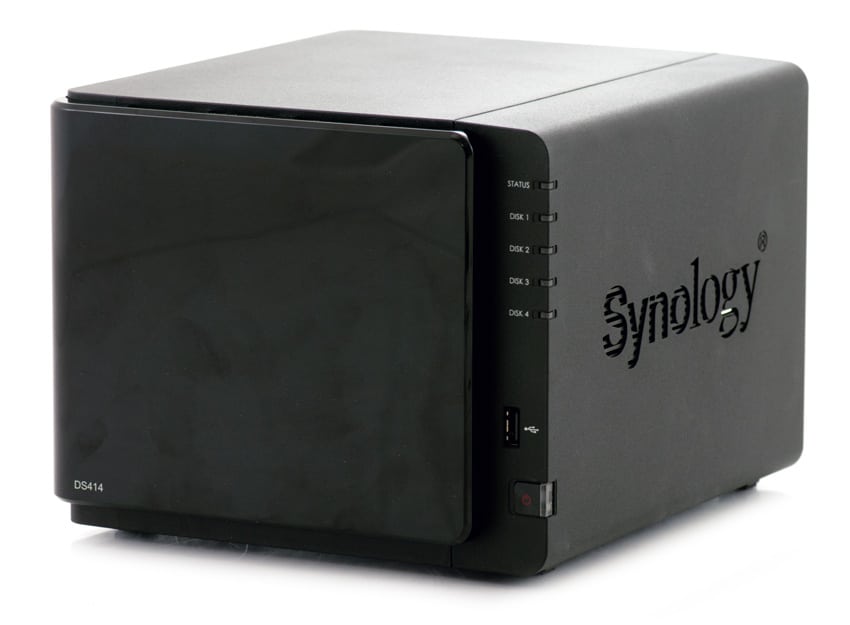
The DS414 is very similar to its predecessor, the DS413. It looks nearly identical and has the same 4 hot-swappable drives with a max capacity up to 16TB, it has two Gigabit ports versus the one that the DS413 had and there is no eSATA port. However the DS414 carries hardware updates and a faster processor for the same price. The DS414 is priced low enough that it could be bought for consumer usage as well. The device would work well for a photographer, video editor, or recording artist that needed lots of capacity and wants to access the information from various workstations. It may be a bit of overkill for the lower end consumers who lean toward two-bay systems, but it is always better to have too much space versus not having enough.
The Synology DiskStation DS414 has a street price of $500.00 bare and comes with a 2-year warranty.
Synology DiskStation DS414 Specifications
- Performance and Storage
- CPU Frequency: Dual Core 1.33 GHz
- Floating Point
- Hardware encrypted storage
- Memory: DDR3 1GB
- Internal HDD/SSD: 2.5” or 3.5” SATA III/SATA II
- Max Internal Capacity: 16TB (4TB HDD x 4, Capacity may vary by RAID type)
- External Interface: USB 3.0 x 2, USB 2.0 x 1
- Hot Swappable HDD/SSD
- LAN: Gigabit x 2
- Wake on LAN/WAN
- Link Aggregation
- Wireless Support (dongle)
- System Fan: 92mm x 92mm x 2pcs
- Power
- Power supply: 90W
- AC Input Power Voltage: 100V to 240V AC
- Power Frequency: 50/60 Hz, Single Phase
- Power Consumption: 39.35W (Access); 14.29W (HDD Hibernation)
- Environmental
- Operating Temperature: 5ºC to 35ºC (40ºF to 95ºF)
- Storage Temperature: -10ºC to 70ºC (15ºF to 155ºF)
- Noise Level: 19.6 dB(A)
- Relative Humidity: 5% to 95% RH
- Maximum Operating Altitude: 6500 feet
- Certification: FCC Class B, CE Class B, BSMI Class B
- Dimensions H x W x D: 165mm x 203mm x 233.2mm (6.5in x 8in x 9.2in)
- Weight: 2.02 kg (4.45 lbs)
- Warranty: 2 years
Design and build
The DS414 is nearly identical to its predecessor in design. It is compact with a minimalist design. It is roughly a cube in shape with a matt black finish. The front of the device is mostly covered in a glossy plastic cover. The four hot-swappable bays are underneath the cover. In order to get to the bays, the user just has to pull off the cover, press down the button above the drive trays, and pull the tray out. On the right hand side, starting at the bottom, is the power button along with indicator light, above that a USB 2.0 port (for quick file transfer/copying), with 5 LED lights indicating status and drive usage.
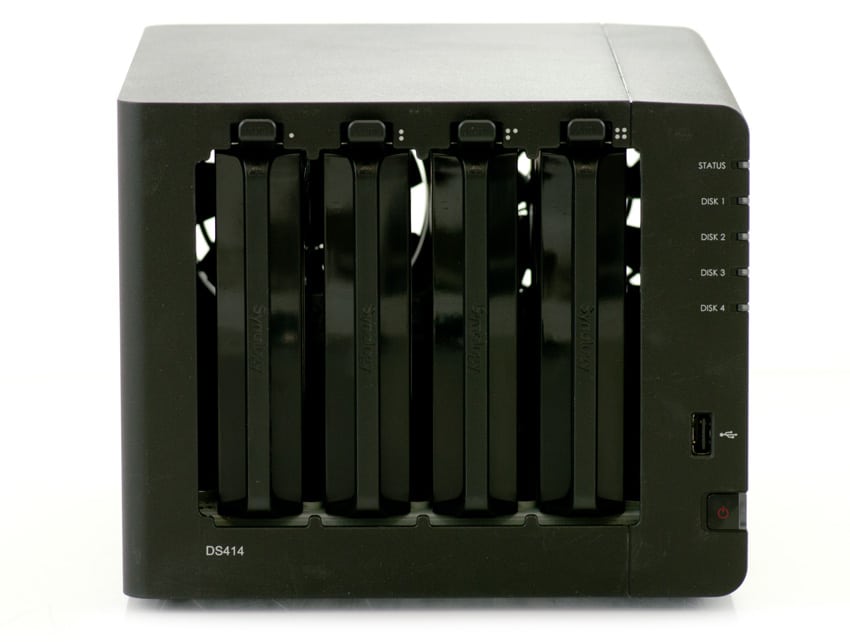
The sides of the device are matte black with Synology branding on both sides. The matt black finish helps to hide the dusty appearance such a device that doesn’t move very often can easily acquire.
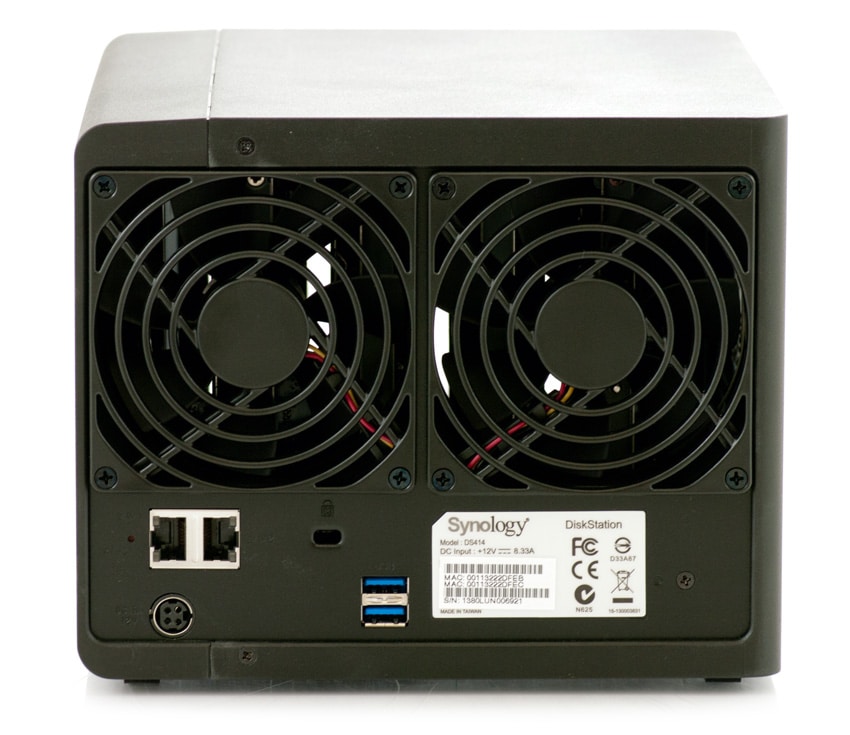
The two 92mm fans are on the rear of the device. Beneath the fans, starting on the left hand side, are two Ethernet ports, an AC adapter port, and a manual reset button. To the right there is the Kensington Lock option and beneath that are the dual USB 3.0 ports.
Testing Background and Comparables
We tested both CIFS and iSCSI performance using two popular 3.5" 5,400RPM hard drives: the WD Red and Seagate NAS models, all 4TB. Both of the drives are suited to operate in NAS environments.
Drives tested for this review:
- WD Red 4TB (5,400RPM)
- RAID1 SMB
- RAID1 iSCSI
- Seagate NAS 4TB (5,400RPM)
- RAID1 SMB
- RAID1 iSCSI
The StorageReview Enterprise Test Lab allows us to provide relevant and unbiased benchmarks of enterprise storage devices by establishing a testing environment comparable to what IT administrators encounter in real datacenter and field deployments. The Enterprise Test Lab incorporates a variety of servers, networking, power conditioning, and other infrastructure to design real-world configurations that accurately reflect the performance of storage devices during reviews.
We incorporate details about our lab environment and testing protocols into the review so that administrators and those responsible for equipment acquisition can fairly gauge the conditions under which we have achieved these published results. None of our reviews are paid for or controlled by the manufacturer of equipment we are testing. Additional details about the StorageReview Enterprise Test Lab and an overview of its networking capabilities are available on those respective pages.
In order to fairly evaluate the performance of the Synology DiskStation DS414 we need an environment that ensures that the DS414 is the I/O bottleneck rather than the network. Therefore this review employs a Lenovo ThinkServer RD240 running multiple Windows Server 2012 VMs in an ESXi 5.1 environment connected via a quad-port Intel i350-T4 NIC through a Netgear ProSafe GS752TXS switch.
- 2 x Intel Xeon X5650 (2.66GHz, 12MB Cache)
- Windows Server 2008 Standard Edition R2 SP1 64-Bit running on VMware ESXi 5.1
- Intel 5500+ ICH10R Chipset
- Memory – 32GB (4 x 8GB) 1333Mhz DDR3 Registered RDIMMs
Netgear ProSafe GS752TXS Smart 52-port Switch
- 48 1GbE Ports, 4 10GbE SFP+ Uplink Ports
- 176Gbps Aggregate Bandwidth
Enterprise Synthetic Workload Analysis
Our enterprise hard drive benchmark process preconditions each device into steady-state with the same workload the device will be tested with under a heavy load of 16 threads with an outstanding queue of 16 per thread, and then tested in set intervals in multiple thread/queue depth profiles to show performance under light and heavy usage. Since hard drives reach their rated performance level very quickly, we only graph out the main sections of each test.
Preconditioning and Primary Steady-State Tests:
- Throughput (Read+Write IOPS Aggregate)
- Average Latency (Read+Write Latency Averaged Together)
- Max Latency (Peak Read or Write Latency)
- Latency Standard Deviation (Read+Write Standard Deviation Averaged Together)
Our Enterprise Synthetic Workload Analysis includes four profiles based on real-world tasks. These profiles have been developed to make it easier to compare to our past benchmarks as well as widely-published values such as max 4k read and write speed and 8k 70/30, which is commonly used for enterprise drives.
- 4k
- 100% Read or 100% Write
- 100% 4k
- 8k 70/30
- 70% Read, 30% Write
- 100% 8k
- 128k (Sequential)
- 100% Read or 100% Write
- 100% 128k
In the first of our enterprise workloads, we measured a long sample of random 4k performance with 100% write and 100% read activity to get our main results. The WD Red 4TB iSCSI provided the greatest throughput in read activity at 935 IOPS, being in the lead by a good margin over the others. The best for write activity was delivered from the Seagate NAS SMB at 532 IOPS with the rest trailing by 25 to 100 IOPS.
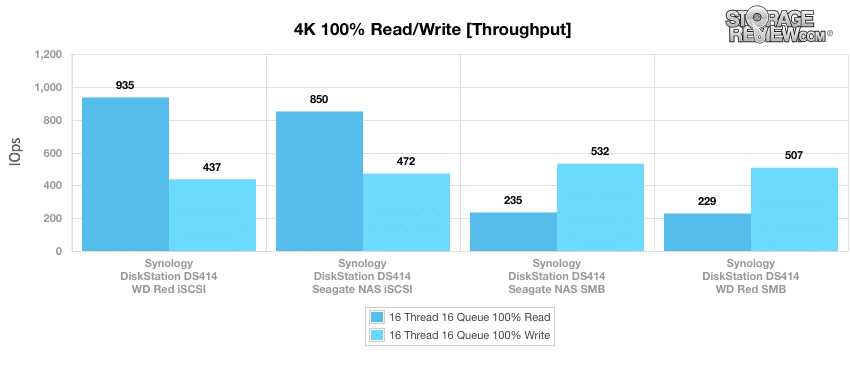
Next we took a look average latency. With a heavy 16T/16Q load, the leaders of the pack are the same as the throughput above. The WD Red 4TB iSCSI had the lowest read latency with 273.5ms and the Seagate NAS SMB the best write latency at 482.48ms.
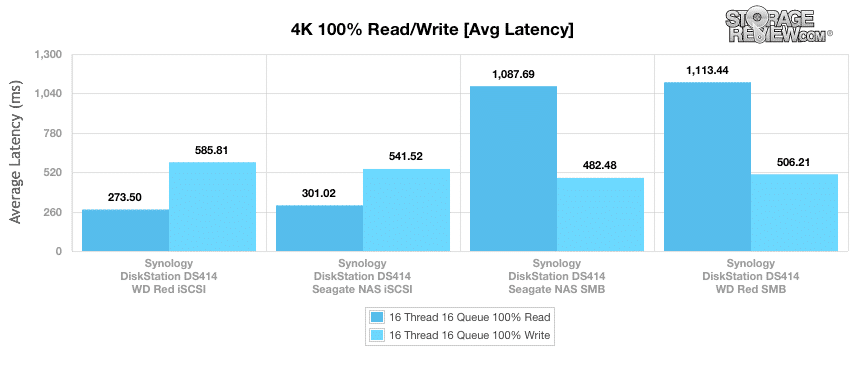
Comparing max latency between the HDDs, the Seagate NAS iSCSI measured a peak of 1259.8ms read and 2865.9ms write, edging out the same measurements from the WD Red.
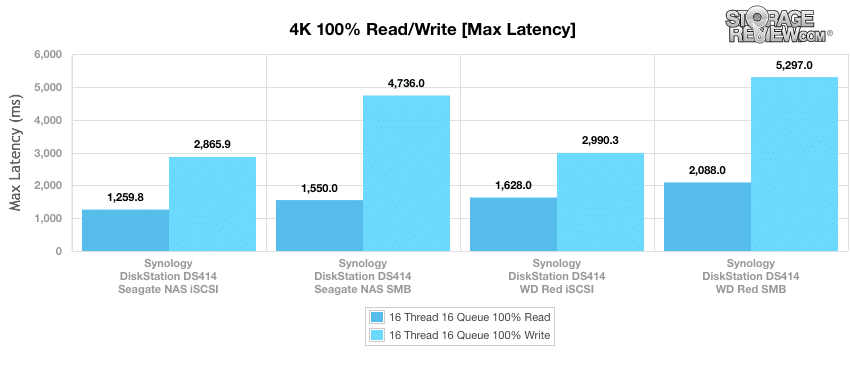
Reviewing the 4K latency consistency in our standard deviation section, the Seagate NAS iSCSI had the best write latency at 453.05ms and the Seagate NAS SMB had the best read latency at 74.26ms.
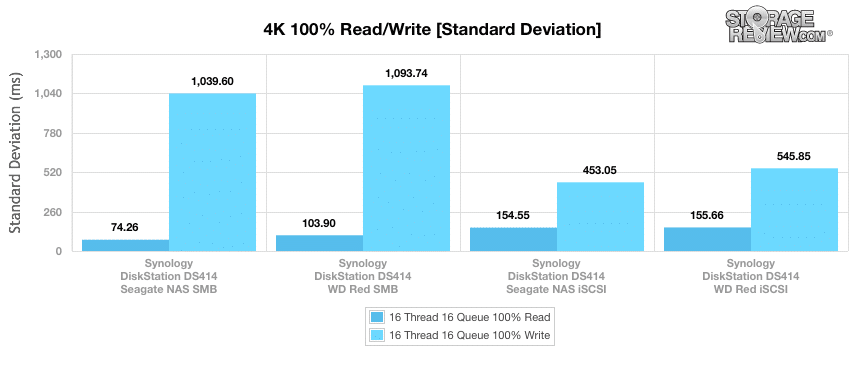
Our next benchmark measures 100% 8K sequential throughput with a 16T/16Q load in 100% read and 100% write operations. While both the SMBs ran neck and neck the WD Red SMB did come out with a slightly higher read activity of 18,657 IOPS and the Seagate NAS SMB just edged out the WD Red SMB with 14,007 IOPS.
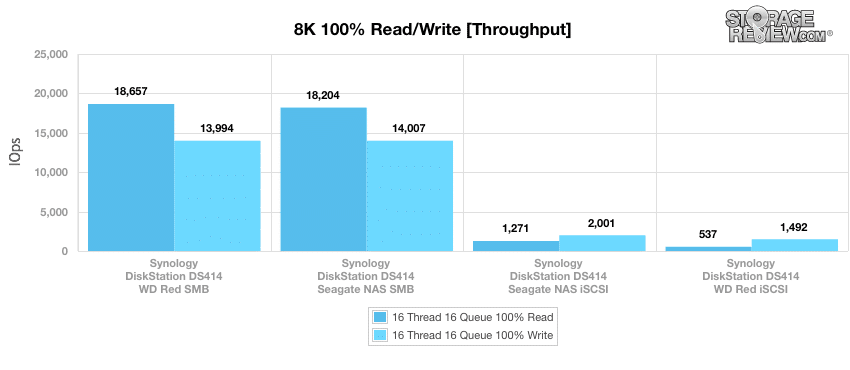
Compared to the fixed 16 thread, 16 queue max workload we performed in the 100% 4k write test, our mixed workload profiles scale the performance across a wide range of thread/queue combinations. In these tests, we span workload intensity from 2 threads and 2 queue up to 16 threads and 16 queue. In the expanded 8k 70/30 test, while both iSCSI both had much higher throughput the WD Red iSCSI did outperform the Seagate NAS iSCSI.
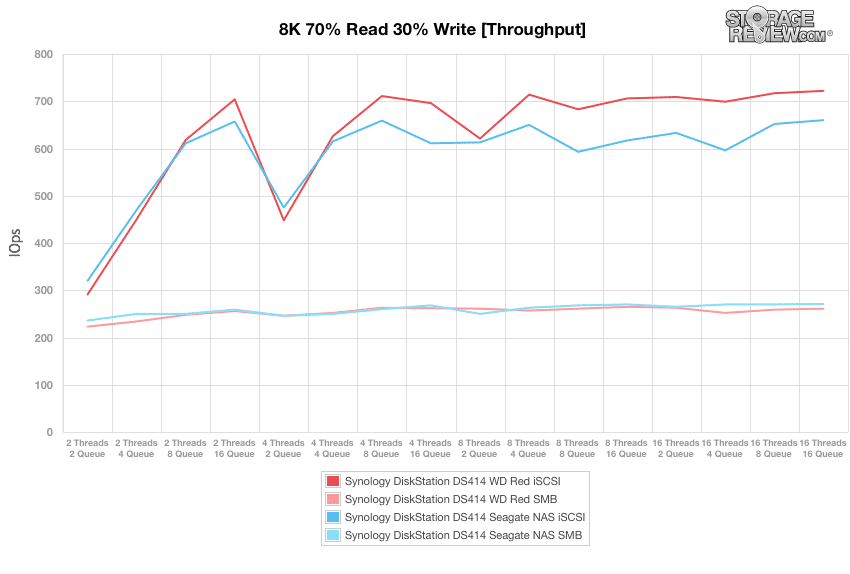
With the 8k 70/30 average response times, again the iSCSI drives had lower latency and again the WD Red iSCSI came out on top with lower times in the higher queue depths and a lower average time overall.
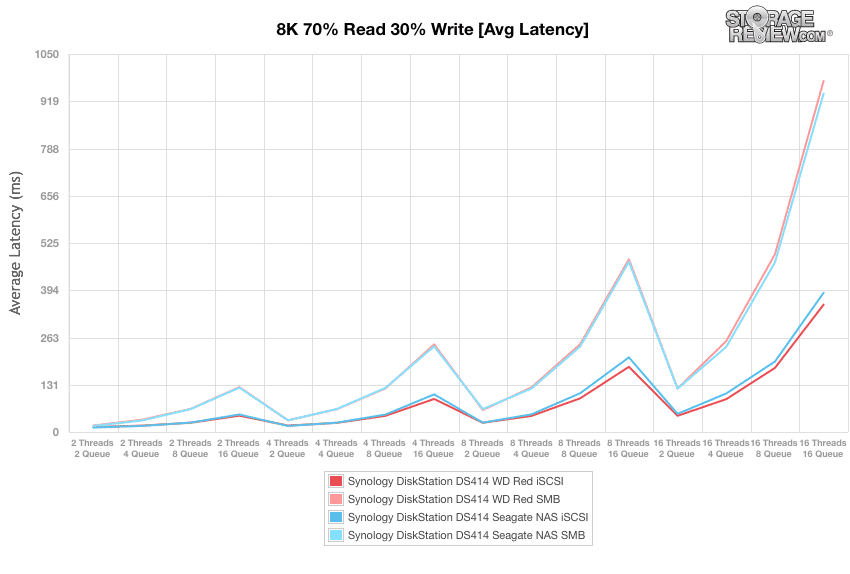
With max latency, we see similar results as the above only the WD Red iSCSI ran a bit stronger throughout with the Seagate NAS iSCSI not giving it a run for its money as much.
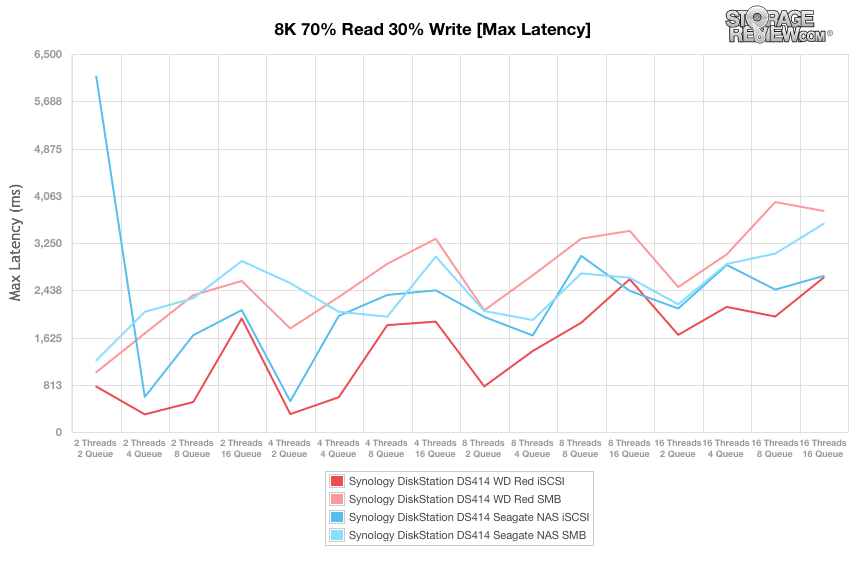
For the entirety of the thread/queue spectrum, the WD Red iSCSI was the top performer.
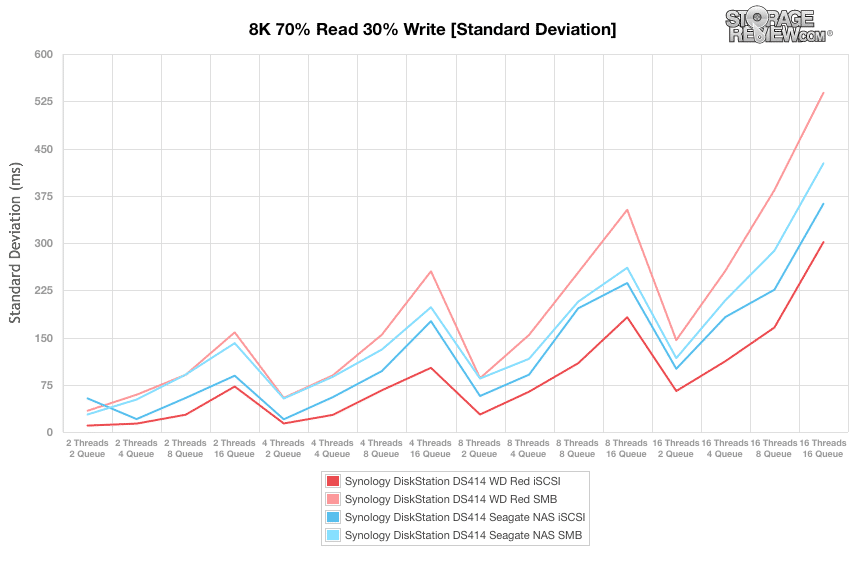
The last test in our Enterprise Synthetic Workload testing is the 128k test, which is a large block sequential test that shows the highest sequential transfer speed for a platter drive. Looking at the 128k performance of 100% write and 100% read activity, the SMB drives were dominant on the read activity and were just about even. The WD Red SMB was slightly better at 231,342 KB/s just 74 KB/s higher than the Seagate NAS SMB. And for write activity it was another close call, though not as close with the WD Red iSCSI coming out on top with a speed of 114,839KB/s almost 800 KB/s faster than the next closest, the Seagate NAS SMB.
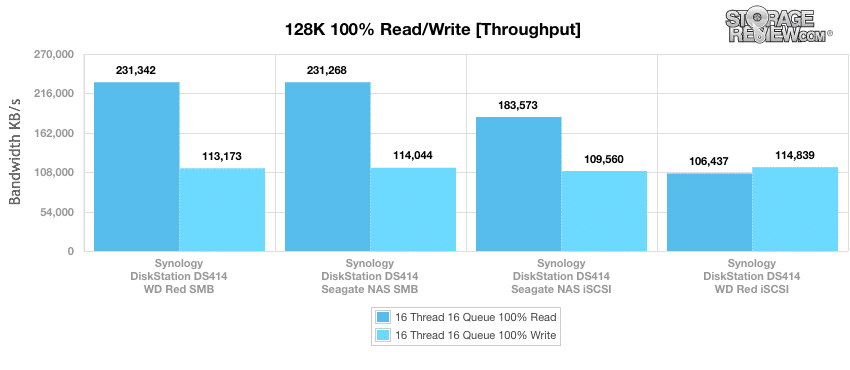
Conclusion
The Synology DiskStation DS414 a 4-bay, hot-swappable NAS with a max capacity of 16TB. The device has a Dual Core 1.33 GHz processor for nearly 1,000 IOPS with NAS HDDs. The DS414 allows for cross platform file-sharing and mobile access. While aimed at small businesses, the device is affordable enough that the consumer who has high capacity backup or media sharing needs can also find great use for the NAS.
We measured the performance of the Synology DiskStation DS414 using popular Western Digital 4TB and Seagate 4TB hard drives optimized for use in small NAS platforms. We found random 4K access performance to top at 935 IOPS read and 532 IOPS write and 8K performances topping at 18,657 IOPS read and 14,007 IOPS write. And we found the device to have large-block sequential speeds at 231MB/s read and 114MB/s write (the read speed was over Synology's claim but the write speed was lacking, the claim being write speeds being over 135MB/s with a disclaimer or different environments producing varying speeds).
Pros
- Good price to capacity ratio
- Extremely capable DSM software and related apps
- Allows cross platform file-sharing
Cons
- No eSATA port
The Bottom Line
The Synology DiskStation DS414 is a high capacity, affordable NAS targeted at SMB and consumers that offers plenty of performance for minimal investment.
Synology DiskStation DS414 at Amazon




 Amazon
Amazon